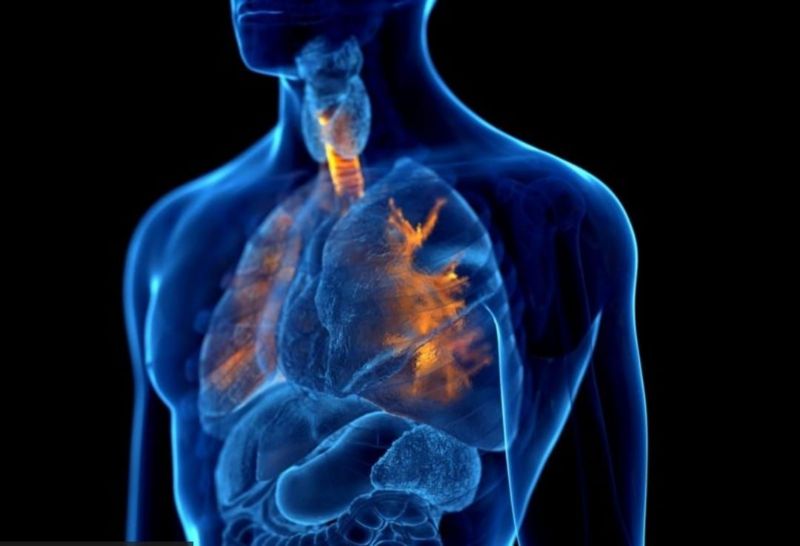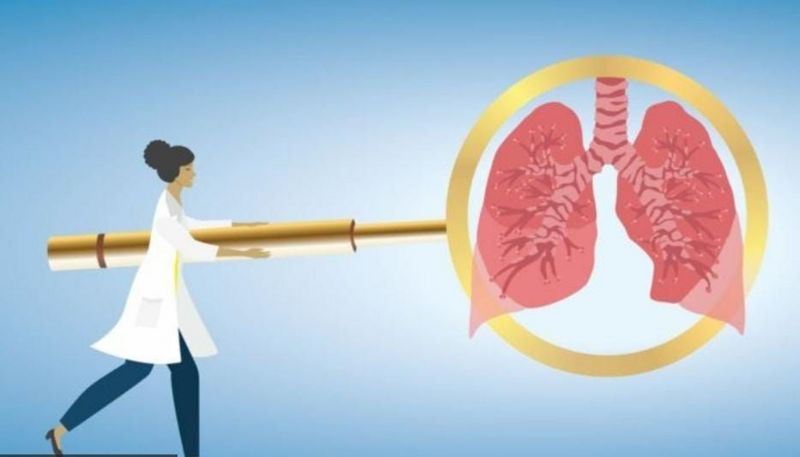For a person with asthma, the bronchi are abnormally sensitive to certain environmental factors.
According to the World Health Organization (WHO) and the Global Asthma Network, up to 334 million people worldwide may be suffering from asthma. In Africa, the prevalence ranges from 4 to 22%.
Doctor Ali Baddredine, a private pulmonologist based in the Senegalese capital Dakar, has enlightened us on the causes, symptoms, and tips for living better with asthma.
What is Asthma?.
Asthma is a chronic respiratory disease that manifests with difficult breathing and wheezing.
It causes difficult breathing and a feeling of suffocation caused by inflammation and contraction of the muscles around the airways, making breathing more difficult for the subject.
Asthma is a disease with no cure, but you can manage it.
“In fact, asthma is a chronic inflammatory disease of the lower airways, specifically the bronchial tubes, and it is defined by the presence of respiratory symptoms. These are the clinical signs, namely respiratory discomfort.
“That is why we call it wheezing Disney. It can also manifest itself as a dry cough or a feeling of chest tightness. All these symptoms vary in time and intensity,” Dr. Baddredine tells us.

What are the symptoms of asthma?
Asthma affects the lungs: Symptoms can appear in the form of cough, wheezing, shortness of breath after more or less intense exercise, a feeling of tightness in the rib cage (in the chest), wheezing, or difficulty breathing normally.
“The frequency and intensity of asthma symptoms can differ from one person to another and depending on the time of the day. It is generally more common at night or early in the morning,” according to Dr. Ali Baddredine.
What are the contributing or triggering factors?
Several factors can trigger asthma symptoms or make them worse.
Genetic predisposition to allergy combined with external environmental factors often triggers the disease.
Inhaling irritating vapors or smoke can cause respiratory distress or an attack in a person who is asthmatic. Some smoke is particularly harmful, such as tobacco smoke, which contains many irritating substances that can aggravate inflammation of the bronchi and trigger an asthma attack.
Prolonged exposure to allergenic substances such as pollens, dust mites, dust, animal hair, mold, household aerosols, solvents, and certain perfumes can also trigger an asthma attack.
“You know that asthma is still a multifactorial disease where several factors are responsible for these manifestations to intervene.
“It has a genetic, hereditary component even if not all asthma is hereditary. And above all, you have the environmental factors, viral infections, pollution in particular, and allergenic exposures.
“You can also have asthma that has an allergic origin without forgetting the irritating factors, especially in our region with incense, atmospheric pollution with all these exhaust gases, temperature variations, air cooling, humidity levels, sand dust,” Dr. Baddredine points out.
What is the link between climate change and asthma?
People with asthma are among the most vulnerable to the effects of climate change. It acts in different ways on the respiratory health of people at risk.
It influences the health of the respiratory tract since the lungs are in direct contact with the outside world and are the first to be exposed to all types of irritation.
According to specialists, asthma attacks are often triggered by pollutants and allergens such as pollen, exhaust fumes (traffic pollution), air pollution (such as the one caused by forest fires), heatwaves, wildfires, dust storms, floods, and increased humidity.
All these elements lead to hyperreactivity because the asthmatic has branches that are hyperreactive, so these will react to the aggressive factors attacking the bronchial mucosa and the reaction that follows, which is bronchospasm or cough caused by different inflammatory phenomena,” Dr. Baddredine warns.
Who is at risk?
Asthma affects people of all ages but particularly younger people. Although the genetic factor is established, the transmission of asthma from parents to children is not systematic.
Although there is no typical profile of people prone to asthma, some people are more likely to develop asthma than others.
This includes people with a family history of asthma, allergic rhinitis or eczema, those born prematurely, children who have had severe and repeated respiratory infections (pneumonia, rhinovirus infection, respiratory syncytial virus, etc.), people who suffer from obesity, those exposed to second-hand smoke and air pollution for a long time, and those with gastroesophageal reflux disease.
According to Doctor Ali Baddredine, “we cannot strictly speak of people at risk because this is not a disease influenced by certain factors, so we cannot speak of risk.
It is true that when you have infants who have repetitive viral infections, it can promote what we call bronchial hyperreactivity, and it makes them wheezy and then asthmatic. But we cannot speak frankly about a population at risk.
It is not like, for example, high blood pressure, or those are subjects who are malnourished, who have excessive consumption of salt, of products that can lead to high blood pressure.
What is the difference between asthma and sinusitis?
Chronic sinusitis is often associated with asthma, but unlike asthma, which affects the lungs, sinusitis affects the sinuses. It is present in almost all patients with asthma symptoms.
The frequent association of asthma and sinusitis comes from the fact that people who suffer from allergic asthma have a greater risk of suffering from sinusitis due to greater sensitivity of their respiratory mucosa.
The specialist’s opinion: “Sinusitis is, in fact, inflammation of the upper airways, and the sinuses are particular, but it has a correlation. There is a similarity of the nasal-sinus and bronchial mucosa.
Not all asthma is associated with sinusitis, but when you have sinusitis, you have to start managing it because in the long run, as it is the same mucous membrane, the inflammation will go down from the upper airways to the lower airways, bronchial, and therefore turn into asthma.

How to treat asthma?
It is important to know that the best treatment for asthma remains prevention. This involves patient education.
To avoid an asthma attack, patients are advised not to smoke or frequent smoky places, to avoid exposure to factors that can trigger or promote the disease, and to avoid using products that can irritate the respiratory tract (like paints, glues, household products, etc.).
If avoiding triggers is not sufficient to maintain good symptom control, people with asthma are recommended to use inhaled corticosteroids, which can treat persistent inflammation in the airways.
“As we have said, it is a chronic inflammatory disease of the bronchi, which means that we must consider having basic treatment and regular monitoring. First of all, we must start by educating the patient. Patient education is awareness of the disease, how to prevent crises that are episodes that can make the disease more serious.
There is a whole therapeutic arsenal, but you actually have to educate the patient to use them correctly because there are different stages of asthma. In fact, you have asthma that we call latent because it does not manifest itself all the time, that is mild, intermittent during a stable period, with no symptoms.
On the other hand, you have some subjects who must be monitored with regular follow-up with the pulmonologist, a functional exploration that has made it possible to quantify asthma and adapt the basic treatment and classify it,” Dr. Ali Baddredine says.

Can asthmatic patients play sports?
Physical activity goes well and is even recommended when asthma is well controlled.
It is possible to reconcile illness and regular sporting activity. Sports allow the acquisition of good muscle mass and improve stress management in people with asthma.
“Sport is one of the cornerstones of treatment. You have athletes and great champions who are asthmatic; the whole point is to manage your asthma well, in fact, and there are treatments that prevent asthma and even asthma products that are not classified as doping products,” Dr. Baddredine notes.
Swimming and aquagym, cycling, walking at a good pace are beneficial for asthmatics.
Running, especially endurance running in cold weather, can cause asthma attacks. To prevent it, the asthmatic must take a bronchodilator 10 to 15 minutes before the race and do a careful warm-up.
Physical activities must be personalized and adapted according to the patient’s age and respiratory performance. People with asthma symptoms should consult a healthcare professional before engaging in sporting activity.
Does asthma kill?

“Oh yes, as much as asthma can be gentle, an attack can take the patient away. You have what we call severe acute asthma. This is a spontaneous serious crisis that can land the patient in intensive care.
There are some people who have interrupted their treatment without medical advice and who have a particular psychological context because there is a psychogenic component of severe asthma attacks, and it is like that especially for adolescents, young girls.
Despite all the therapeutic arsenal we have, we must also not forget that sometimes there are some diagnostic errors, which can be an overdiagnosis of asthma. We can have subjects who have died of what we call an asthma equivalent, especially elderly subjects; they have what we call pseudo-cardiac asthma.
So sometimes we say they died of asthma when they died of another disease that resembles asthma, especially in the elderly,” Dr. Ali Baddredine warns.
Asthma can be a serious illness, but it can also be managed with appropriate treatment.
Poorly controlled asthma can cause irreversible symptoms and lead to an attack or respiratory distress, and that can be fatal.
During an attack, the opening of the bronchi is reduced due to a significant inflammatory reaction and contraction of the muscles in the wall of the bronchi. Normal breathing becomes almost impossible for the patient.
Although attacks can be effectively calmed by medication, they are potentially dangerous, especially in vulnerable people (young children, elderly people, those suffering from a respiratory infection, etc.).
Inflammation of the respiratory tract produces thick mucus inside the bronchi, and this hinders air circulation.
Living with asthma is a difficult challenge, but it is not impossible to meet as long as you follow a few daily rules.
By adopting a healthy lifestyle, avoiding triggers, and following appropriate treatment, it is possible to control the disease and lead a full and active life, virtually symptom-free.






